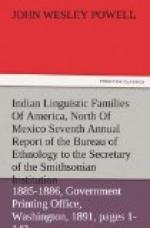> Killiwashat, Latham, Nat. Hist.
Man, 325, 1850 ("mouth of the
Umkwa").
X Klamath, Keane, App. Stanford’s
Comp. (Cent. and So. Am.), 475, 1878
(cited as including Yacons).
Derivation: From yakwina, signifying “spirit” (Everette).
The Yakwina was the leading tribe of this family. It must have been of importance in early days, as it occupied fifty-six villages along Yaquina River, from the site of Elk City down to the ocean. Only a few survive, and they are with the Alsea on the Siletz Reservation, Tillamook County, Oregon. They were classed by mistake with the Tillamook or “Killamucks” by Lewis and Clarke. They are called by Lewis and Clarke[111] Youikcones and Youkone.[112]
[Footnote 111: Allen, ed. 1814, vol. 2, p. 473.]
[Footnote 112: Ibid., p. 118.]
The Alsea formerly dwelt in villages along both sides of Alsea River, Oregon, and on the adjacent coast. They are now on the Siletz Reservation, Oregon. Perhaps a few are on the Grande Ronde Reservation, Oregon.
The Siuslaw used to inhabit villages on the Siuslaw River, Oregon. There may be a few pure Siuslaw on the Siletz Reservation, but Mr. Dorsey did not see any of them. They are mentioned by Drew,[113] who includes them among the “Kat-la-wot-sett” bands. At that time, they were still on the Siuslaw River. The Ku-itc or Lower Umpqua villages were on both sides of the lower part of Umpqua River, Oregon, from its mouth upward for about 30 miles. Above them were the Upper Umpqua villages, of the Athapascan stock. A few members of the Ku-itc still reside on the Siletz Reservation, Oregon.
[Footnote 113: U.S. Ind. Aff. Rept., 1857, p. 359.]
This is a family based by Hale upon a single tribe, numbering six or seven hundred, who live on the coast, north of the Nsietshawus, from whom they differ merely in language. Hale calls the tribe Iakon or Yakones or Southern Killamuks.
The Sayusklan language has usually been assumed to be distinct from all others, and the comments of Latham and others all tend in this direction. Mr. Gatschet, as above quoted, finally classed it as a distinct stock, at the same time finding certain strong coincidences with the Yakonan family. Recently Mr. Dorsey has collected extensive vocabularies of the Yakonan, Sayuskla, and Lower Umpqua languages and finds unquestioned evidence of relationship.
GEOGRAPHIC DISTRIBUTION.
The family consists of four primary divisions or tribes: Yakwina, Alsea, Siuslaw, and Ku-itc or Lower Umpqua. Each one of these comprised many villages, which were stretched along the western part of Oregon on the rivers flowing into the Pacific, from the Yaquina on the north down to and including the Umpqua River.
TRIBES.
Alsea (on Alseya River).
Yakw[vi]’na.
Kuitc.
Siuslaw.




